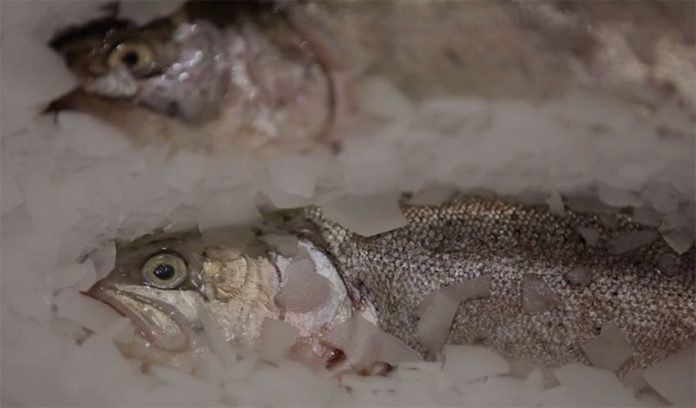Mexico City consumers are being ripped off when they buy frozen fish and shrimp at supermarkets because they are charged for the protective layers of ice that cover them, a new study has found.
Conducted by the ocean conservation and advocacy organization Oceana, the study Agua por Pescado (Water for Fish) analyzed 82 samples of fish and shrimp bought at 10 different supermarkets operated by 10 different chains that have a presence in the capital.
The study found that in 98% of cases, the ice with which the seafood was glazed was charged at the same price as the fish and shrimp. Up to 57% of the total weight of a product purchased was not fish or shrimp but ice, Oceana found.
Profeco, the federal consumer protection agency, is unable to sanction the offending supermarkets because there is no legal framework that regulates the practice of seafood glazing. In any case, it is unclear whether the protective layer of ice is placed over the seafood by the supermarkets themselves or by processing plants.
In an interview with the newspaper Milenio, the transparency campaign director at Oceana México described the findings of the study as “alarming.”
Renata Terrazas said that in no cases were those purchasing the glazed fish and shrimp notified that they were also paying for the ice that covered them.
“The percentages [of ice] range from 4% to 57% and in all cases, they [the supermarkets] charged for the ice,” she said, explaining that the total weight of one sample of imported shrimp was found to be 57% ice.
“We bought a kilogram of shrimp that ended up being only 430 grams shrimp and the other 570 grams were water,” Terrazas said.
“We’re buying water at the price of fish and shrimp and they’re not telling us. When you go to the supermarket and see a kilo of imported catfish or tilapia at 90 or 100 pesos, the reality is that’s not the final price. You’re not buying a kilo of fish; you’re buying 700 grams or even half a kilo [but] they sell it to you as if it were a kilo of fish.”
Terrazas said that imported seafood was found to be covered with thicker layers of ice than Mexican products. The ice-to-seafood ratio was highest among shrimp and fillets of catfish and tilapia, she said.
“We found patterns: the highest percentages [of ice], 30% to 57%, were all imported products. [All of] the domestic product has less than 30% glazing; on average it has less than 20%,” Terrazas said.

“So, if you see Mexican shrimp in the supermarket at 380 pesos a kilo as opposed to imported shrimp, which on average is 270 pesos, you might think that [the imported product] is cheaper and buy it. However, imported shrimp has, on average, 31% glazing compared to 13% for the domestic product. When you do the math, they’re practically the same price,” she said.
The campaign director said that the solution to the fraudulent practice of charging for ice as if it were seafood lies in the implementation of a “policy of traceability” that provides information about the processes that seafood goes through “from the boat to the plate.”
Terrazas said that Oceana is speaking to federal agricultural authorities, including the National Aquaculture and Fishing Commission, about that possibility but added that the cooperation of Profeco, the Economy Ministry and the Federal Commission for Protection Against Health Risks is also required.
“If all of the relevant actors aren’t present, the policy of traceability cannot be built along the whole chain,” she said.
However, it will be Profeco that has the responsibility to ensure that consumers are not defrauded at the point of sale, Terrazas said.
Oceana is also proposing that all seafood sold in supermarkets be labeled with information including the scientific and commercial name of the product; where it was caught; when it was caught; how it was caught; who caught it; and the processes it went through after capture (freezing, glazing, packing, etc.).
That would help stamp out the widespread practice of fish being advertised and sold as something other than it actually is.
A 2019 study by Oceana analyzed 400 portions of fish purchased from 133 fish markets, supermarkets and restaurants in Mexico City, Cancún and Mazatlán. Through DNA testing, the study found that 31% of the samples were not as advertised.
“Every day, hundreds of consumers in Mexico ask for one species and get another,” Terrazas said after the study was published in March 2019.
Source: Milenio (sp)
